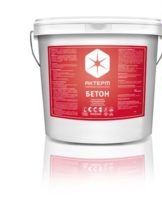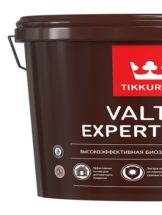Varieties of self-leveling floor primers, how to choose the best and application
The growth in demand for self-leveling floors is due to the fact that this type of finish makes it possible to achieve a uniform coating, resistant to abrasion and having a long service life. However, in order for the material to acquire such properties, it is necessary to properly prepare the base. In such cases, it is imperative to use self-leveling floor primers. After such processing, the likelihood of delamination of the material from the base is excluded.
Do I need a primer for a self-leveling floor?
Self-leveling floors are applied on a concrete base, which has a porous structure. Due to this, the surface absorbs moisture well, which deteriorates the level of adhesion between the two materials. That is, without eliminating the indicated drawback of concrete, it is impossible to get a strong and durable self-leveling floor.
Also, the moisture that was absorbed into the base eventually comes out.As a result, the finishing material applied on top begins to peel off.
Primer mixes are able to avoid such consequences. These formulations come in the form of a highly concentrated powder, which is diluted in water or a ready-to-use liquid before application.
Primer properties and functions
Due to its special composition, the primer has the following characteristics:
- penetrating into the structure of the porous surface, the mixture retains small substances and eliminates microcracks, thereby increasing the strength of the base;
- forms a protective layer against moisture;
- prevents the formation of mold and mildew;
- increases adhesion, thus increasing the life of self-leveling floors.
Without preliminary priming of the base, the floor begins to swell and crack after 1-2 years. These consequences occur more quickly in rooms with high humidity: bathroom, shower, sauna, etc. In such rooms, it is recommended to use a floor with deep penetration, which forms a waterproofing layer and does not allow moisture to pass through the "rough" floor.

Advantages and disadvantages of applying a primer coat
The preparation of the surface before pouring the floor has several objectives:
- Decrease in the amount of moisture absorbed. Water penetrates the concrete base due to its porous structure. This leads to premature destruction of the material.
- Increased adhesion. Thanks to this feature of the primer, the self-leveling floor adheres better to the base, which increases the service life of the coating.
- Even coverage distribution. Because the primer eliminates small pores and increases adhesion, the floor does not spread during pouring.
- Reduced material consumption. This is also achieved through increased grip.
The only disadvantage of priming the base before pouring the floor is that it significantly increases the duration of the work.

Suitable soil types and selection recommendations
Due to the fact that more than 10 different types of primers are used for pouring the floor, it is necessary to choose this material taking into account the scope of application. The main criterion influencing the purchase of the mixture is the type of base.
Universal primers are used for processing wood, iron, concrete and other surfaces. However, some of these formulations contain latex or acrylic. Primers with these components are not recommended for application on concrete substrates, as these materials do not provide sufficient adhesion.
If you plan to pour the floor on a surface containing alkalis (used to increase fire resistance), the material containing components resistant to the specified substance should be used as a protective mixture. In cases where the concrete base does not require leveling, compounds marked as "finishing" can be used as the floor.
If the work is carried out in rooms with constantly high humidity, then it is recommended to use deep-penetrating mixtures in such conditions. Such formulations create a waterproofing layer that does not allow water to see through the concrete base. Also, in such cases, antifungal additives should be added to the soil or the surfaces should be treated with antiseptic compounds before applying the material.

Adhesive
Adhesive primers contain quartz sand, which gives the dried layer a rough surface. Therefore, these protective materials are more popular than others when pouring floors.In addition to quartz sand, adhesion primers include:
- polyurethane resins;
- modifiers;
- pigments.
Adhesive primers are used in the preparation of almost all types of substrates except those that actively absorb moisture.
Multi-floors
Multi-floors are rare on the market due to limited supply. Despite this, such mixtures are versatile and suitable for processing:
- drink;
- gland;
- ceramic;
- Rock;
- gypsum;
- mineral and bituminous bases;
- painted surfaces and the like.
Multi-primer is based on various resins and polymers including polystyrene, glyphthalic, etc. Due to such a complex composition, only professionals can work with such materials.

Reinforcement
The composition of such primers includes polymers, acrylates, polyurethane, additives and additives that strengthen the surface by binding the base components and eliminating pores. In particular, deeply penetrating mixtures, due to this effect, are able to reduce moisture absorption. In this case, the material does not affect the vapor permeability of the base.
Reinforcement primers often contain coloring pigments that identify untreated areas upon application. Materials of this type dry quickly: the process takes no more than two hours.
Universal
Universal primers are made on the basis of water, solvent and solvents. These compositions differ in the following features:
- wide range of applications (suitable for different bases and operating conditions);
- strengthen the base;
- increase adhesion;
- reduce absorbency.
At the same time, universal floors are weaker than specialized floors for each property.Water-based formulations do not emit an unpleasant odor. Mixtures containing solvents are toxic and flammable. Therefore, these products should not be used indoors.

Epoxy
Epoxy primers are considered optimal for reinforcing concrete screeds. Also, similar mixtures are used in the preparation of wood and base with asphalt.
Epoxy primers are available in two separate containers containing the composition itself and the hardener. Due to their thick consistency, these mixtures level the base well, filling cavities and flaws. It is recommended to combine these compounds with epoxy self-leveling floors.
Polyurethane
Polyurethane primers are used to pour floors of the same name on the following bases:
- cement-sand screed;
- metal;
- TREE;
- ceramic tile;
- concrete.
Polyurethane mixtures are used in the processing of concrete only as a finishing coat. The first is applied with an epoxy primer.

Acrylic and latex
Acrylic and latex primers are recommended for the preparation of plaster screeds and wooden substrates. Such mixtures do not eliminate surface defects, therefore they are not used in the preparation of concrete and other mineral materials.
Metal methacrylate
Metal methacrylate floors are characterized by the following characteristics:
- dry quickly;
- significantly increase adhesion;
- differ in increased coverage capacity.
Due to these features, metal-methacrylate floors are expensive, so they are more often used for emergency preparation of the base. In terms of depth of penetration into concrete, these compositions are inferior to epoxy and polyurethane.

Deep penetration primer
Such primers can penetrate to a depth of 10 centimeters.Thanks to this characteristic, the mixture prevents the release of resins from the wood. In addition, these primers do not allow water to penetrate the structure of the base and prevent moisture from escaping from concrete and other materials.
Ranking of the best self-leveling floor primer brands
The most popular primers for pouring floors are products of the following brands:
- Bergauf. Under this brand, various types of primers are produced, including deep penetrating. The mixtures are of high quality and non-toxic composition.
- Ceresit. The company also manufactures various types of primers, including mixes used to reinforce concrete.
- Knauf. A wide range of products from this brand includes primers that protect the base from alkalis.

Application rules
When priming surfaces, a number of conditions must be observed that determine the service life of the material. In particular, the recommendations of the mixture manufacturers regarding the temperature at which the composition can be applied must be taken into account.
Calculation of consumables
The consumption of the primer is determined both by the type of material used and by the characteristics of the base. This parameter is usually indicated on the package with the mixture. On average, when applying the first layer, 250-500 grams of epoxy and polyurethane primer are consumed per square meter. In the future, the new coating will require 100-200 grams.
Tools required
Use rollers or brushes to apply the primer. Also, when working with this material, you may need containers for mixing the solution (this is important for epoxy primers) and tools for surface preparation.

Surface preparation
It is recommended that you perform the following operations before booting the database:
- Remove the old coating. This should also be done if the paint or plaster has peeled off.
- Remove all dust and dirt. Even small particles form visible defects on the surface after pouring the floor.
- Fill in seams and other flaws, then sand the base.
- Rinse and dry the base.
After the last operation, it is recommended to lay polyethylene on the surface and leave the base for 24 hours. If traces of moisture appear during this period, the soil must be dried within three days.

Primer application and drying time
You need to prime the floor after the base is completely dry. This procedure is carried out according to the following algorithm:
- A primer solution is prepared according to the manufacturer's recommendations for the particular mixture.
- The mixture is applied evenly to the substrate. You should start at the far corner, heading towards the door.
- The first layer is left to dry.
- The second and subsequent layers are applied. The amount of material applied is determined depending on the tasks that the primer should solve and the characteristics of the base.
The drying time of the primer is indicated on the packaging with the mixture. But, regardless of the type of material chosen, it is not recommended to fill the floor earlier than two days later.
Precautionary measures
It is recommended that priming work be carried out in a well-ventilated area. If the mixture contains solvents, the material should be kept away from open flames and personal protective equipment should be worn.

What mistakes beginners make
Basically, errors in priming surfaces occur due to non-compliance with the rules for preparing a working solution or base.Moreover, the second case occurs more often. Before priming and pouring the floor, the surface should be thoroughly cleaned of old coating, debris and other contaminants.
Advice from the masters
When priming under self-leveling floors, it is recommended to process the joints with the walls with a sealant. Areas where the mixture should not enter should be sealed with tape. It is also important to follow the manufacturer's recommendations regarding the finishing conditions of the work.



